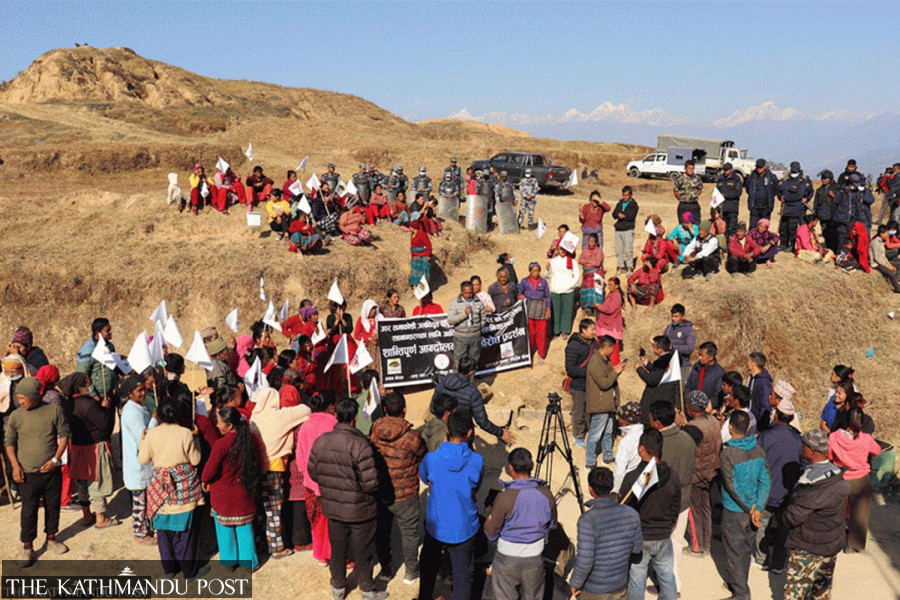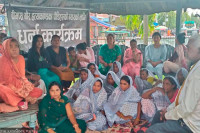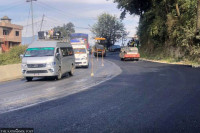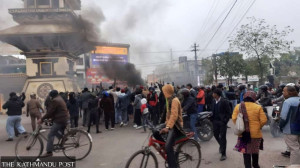National
Lapsephedi protest hints at challenges in expansion of transmission lines
The Nepal Electricity Authority and the agitating locals have reached truce to calm down the situation.
Prithvi Man Shrestha
Nepal Electricity Authority (NEA) is facing obstructions in constructing transmission line projects in different parts of the country with the latest being reported in the construction of a substation at Lapsephedi area of Shankarapur Municipality-3.
Though the state-owned power utility reached a temporary truce with the agitating locals on Friday evening, the sides are yet to reach a consensus on whether to relocate the proposed substation from Bojhini area of Lapsephedi, as demanded by the locals.
Due to obstruction from the locals who are arguing that the substation should not be built around the human settlements, the future of the 400kV Naya Khimti-Barhabise-Lapsephedi transmission line, which the NEA says is vital for meeting the growing power demands in the Kathmandu Valley, has become uncertain.
According to the NEA, the project is in its final phase of completion with just one substation at Bojhini and four transmission towers being the only remaining tasks to be completed before the transmission of electricity through this power line starts.
Even after the locals whose lands were acquired received the compensation, protests were organised on the instigation of other unrelated people, the NEA says.
After facing continued obstruction for the last two weeks, the NEA on Friday invited a group of agitating locals to discuss the matter and they reached a three-point agreement to ease the situation after five-hour-long negotiations, according to the power utility body.
In a statement on Saturday morning, the NEA said that the locals have agreed to discontinue their obstruction, while the local administration would withdraw the police mobilised there.
A coordination committee has been formed, headed by ward-7 chairperson Bishnu Prasad Shrestha, which will discuss with the locals and submit its report within five days.
Though the deal brought a temporary truce between the two sides, the conflict also exposed the wider problems that transmission line projects are facing in the country as a large number of hydropower projects are in the pipeline, according to NEA officials.
Due to a delay in completing the construction of the Naya Khimti-Barhabise-Lapsephedi transmission, the NEA has failed to bring the power generated from the country’s largest 456MW Upper Tamakoshi Project directly to the Kathmandu Valley. After the Upper Tamakoshi came into commercial operation in August 2021, its power has been taken to Dhalkebar from where electricity is being transmitted to the eastern region as well as Kathmandu. “Because of the long distance, the NEA has higher power leakages,” said Dirghayu Kumar Shrestha, chief of the Transmission Directorate at NEA.
Shrestha said there is hardly any transmission line project in Nepal that has not faced hindrances and that not even a single project has been completed without time and cost overruns.
Other projects are also facing different problems from different sectors, according to the NEA.
For example, the under-construction 220kV Bharatpur-Bardaghat Transmission Line Project has remained incomplete as the locals of Dumikas, Nawalparasi (Susta East) have been obstructing the construction of two transmission towers in the area.
The NEA said although it has already installed 244 of the 246 towers of the 74-km transmission line, it has not been able to transmit power at 220kv capacity due to obstruction to the installation of two towers.
The project’s work was stalled for more than a year after the Supreme Court in April 2021 issued an interim order to stop work on the two last pylons. On June 27 last year, the court vacated the interim order clearing the path for the project to resume the erection of the remaining pylons. “Despite the court order, locals have been obstructing the work in the transmission line,” said Shrestha. There is a dispute over how to better compensate the locals.
Shrestha said that a land valuation team led by the Chief District Officer of Nawalparasi (Susta-East) is conducting the valuation of the lands whose compensation should be provided. “Remaining work in the project will now move forward,” he said.
Likewise, the 400 kV Hetauda-Dhalkebar-Inaruwa transmission project has also faced prolonged delays due to the court case it faced.
On January 30, 2019, Sarita Giri, a former minister, filed a petition in the Supreme Court demanding a change in the route of the transmission line in the Padariya area of Lahan Municipality and the court issued an interim order in response. After more than three years since the interim order was issued, the court in early June last year vacated the interim order. Shrestha said that the work on the project has just begun after the interim order was vacated.
New Modi (Parbat)-Laha Chowk (Kaski) 132 kV double circuit transmission line came into operation in December 2021. “But the Laha Chowk-Lekhnath section of the transmission line was obstructed by the locals, for months, by not permitting two towers,” said Shrestha. “We are now working on the project by using the police force.”
The NEA also has had a bitter experience with the 220kV Khimti-Dhalkebar transmission line project. The Khimti-Dhalkebar project started in 2004 but was completed only in 2018 after a prolonged compensation dispute brought up by the locals in Sindhuli. It was a project built with the assistance of the World Bank. “As long as the World Bank was funding, locals and non-government organisations obstructed the works in the project,” said the NEA Managing Director Kul Man Ghising. “Only after the exit of the World Bank, we used the administrative power to remove the obstacles to complete the project.”
The under-construction 132kV Thankot-Chapagaun-Bhaktapur transmission line has been facing never-ending obstructions from the locals. It has been a work in progress since 2004 with the residents of Lalitpur unwilling to give up their lands and provide the right of way at the proposed rates.
“Locals from Harisiddhi, Lagankhel and Khokana have not allowed us to construct the transmission line,” said Shrestha. “Had the project been implemented when the compensation was fixed in its early years, the project would have been completed.”
The obstruction in Lapsephedi also exposes the challenges the NEA is facing while expanding the 220kV transmission line around the Valley, projecting that there will be a demand for 3,000 megawatts of electricity in the Valley by 2050.
For this, 20 new substations need to be built inside the Valley, according to the NEA. “If obstructions like the one in Lapsephedi continue, it will be hard to build other substations,” Shrestha said.




 6.3200000000001°C Kathmandu
6.3200000000001°C Kathmandu








%20(1).jpg&w=300&height=200)






